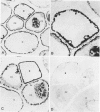Abstract
Cytochemical techniques employing lead-precipitation of enzymically released inorganic phosphate have been widely used in attempts to localize the plasma membrane proton pump (H+-ATPase) in electron micrographs. Using Avena sativa root tissue we have performed a side-by-side comparison of ATPase activity observed in electron micrographs with that observed in in vitro assays using ATPases found in the soluble and plasma membrane fractions of homogenates. Cytochemical analysis of oat roots, which had been fixed in glutaraldehyde in order to preserve subcellular structures, identifies an ATPase located at or near the plasma membrane. However, the substrate specificity and inhibitor sensitivity of the in situ localized ATPase appear identical to those of an in vitro ATPase activity found in the soluble fraction, and are completely unlike those of the plasma membrane proton pump. Further studies demonstrated that the plasma membrane H+-ATPase is particularly sensitive to inactivation by the fixatives glutaraldehyde and formaldehyde and by lead. In contrast, the predominant soluble ATPase activity in oat root homogenates is less sensitive to fixation and is completely insensitive to lead. Based on these results, we propose a set of criteria for evaluating whether a cytochemically localized ATPase activity is, in fact, due to the plasma membrane proton pump.
Full text
PDF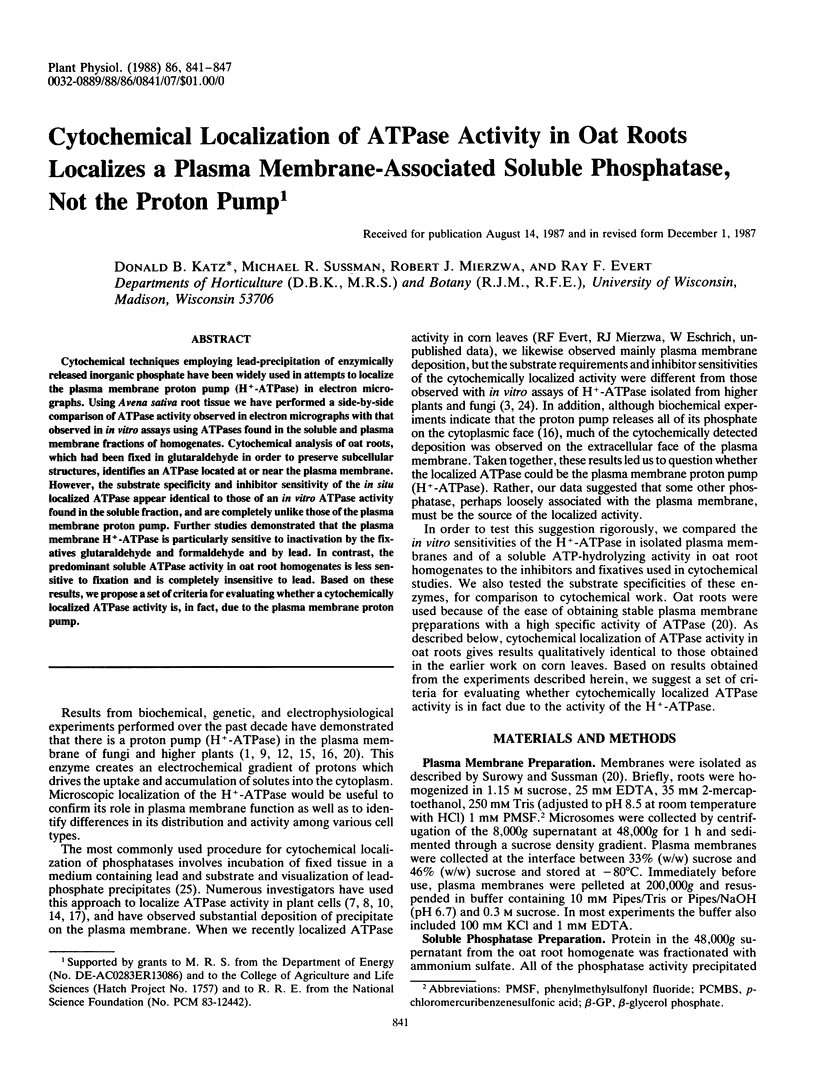

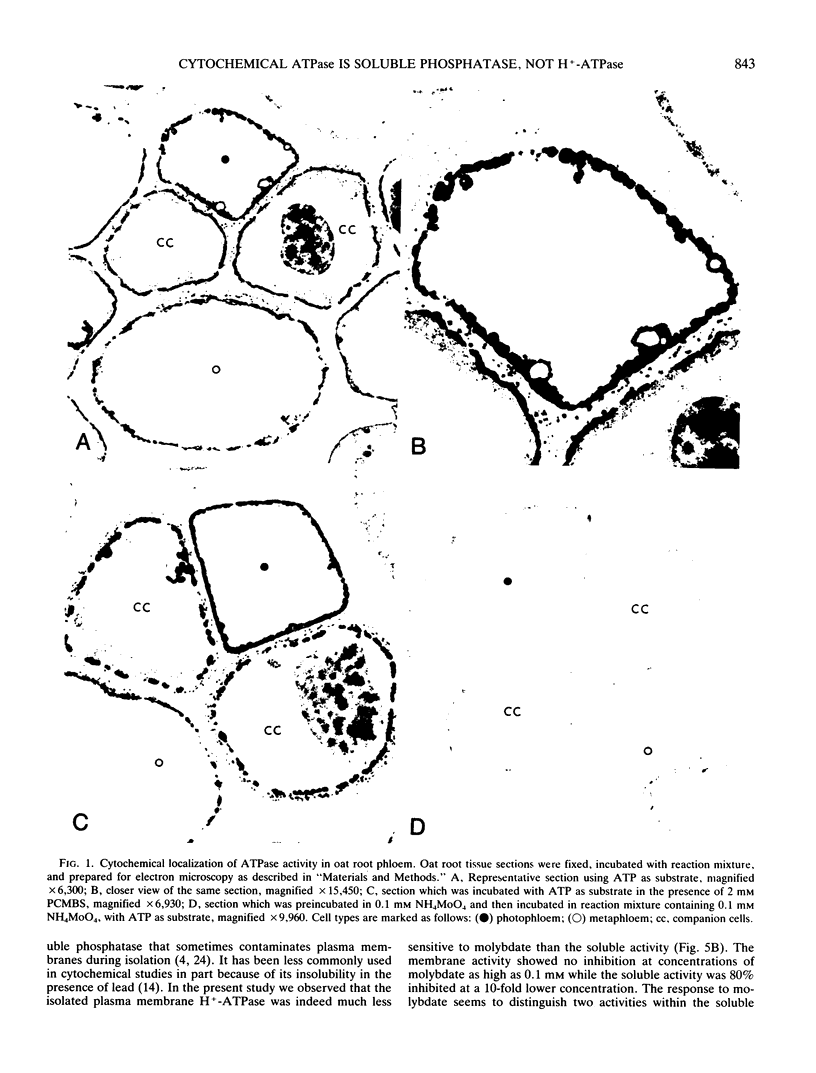
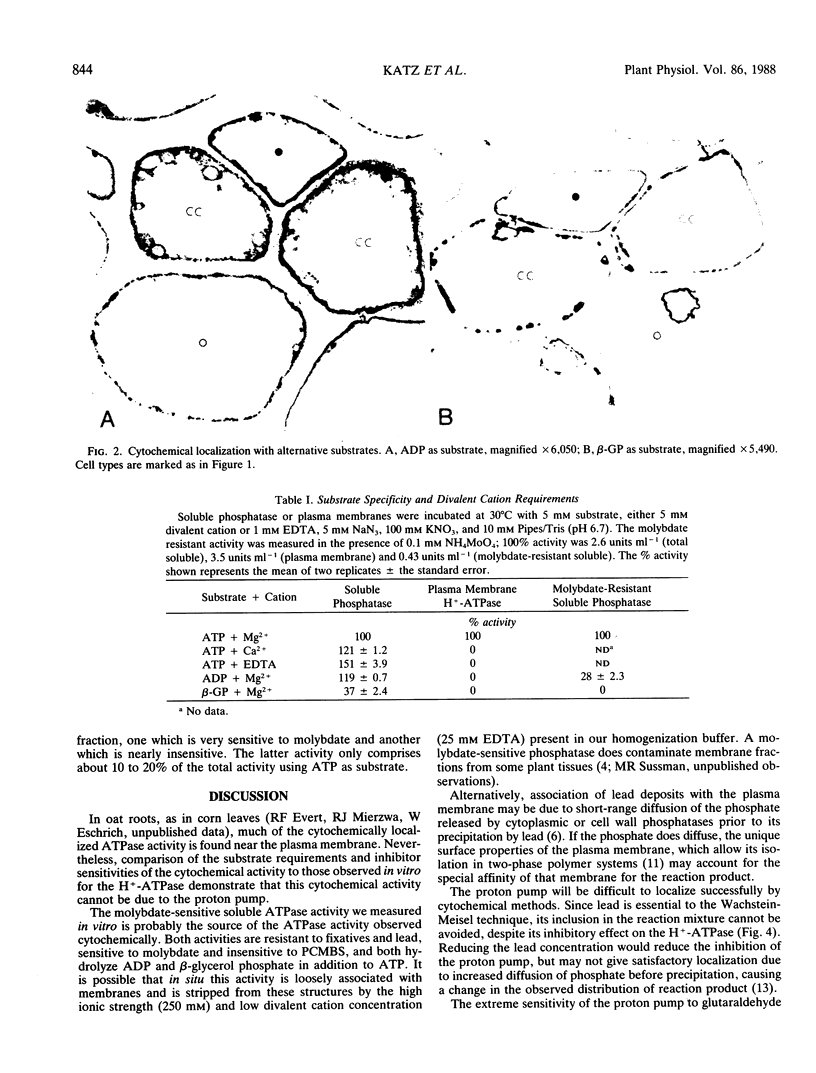
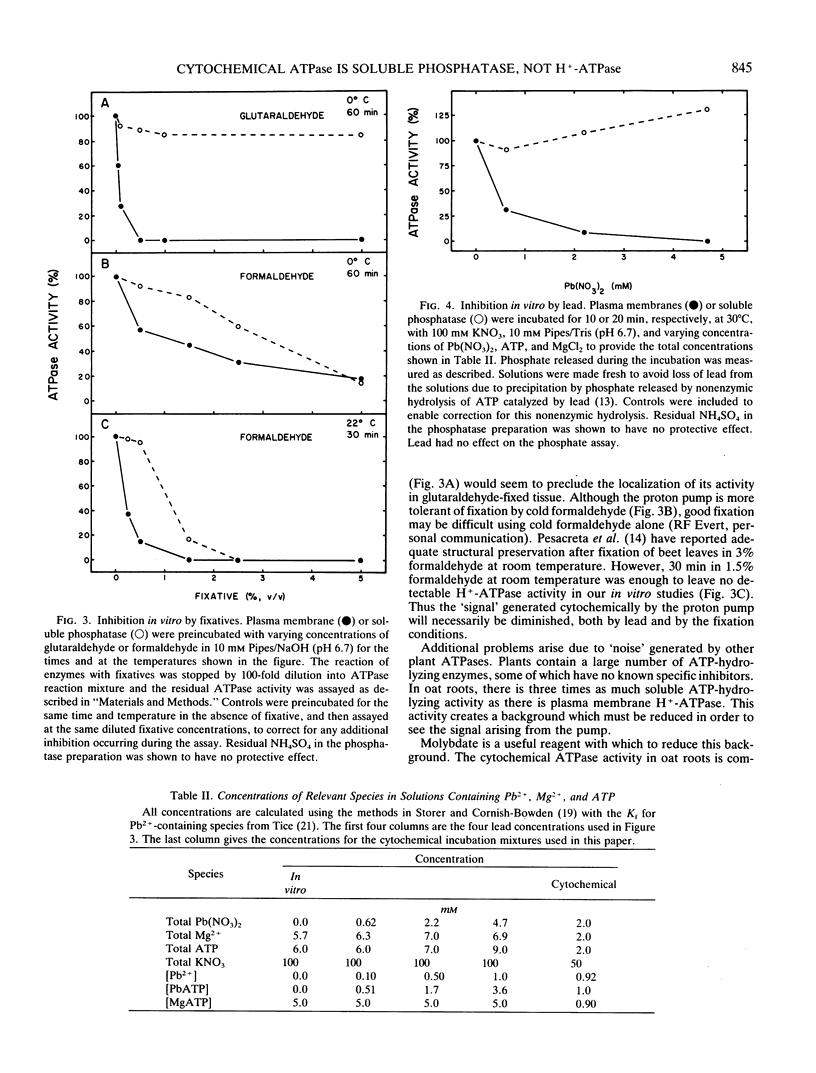
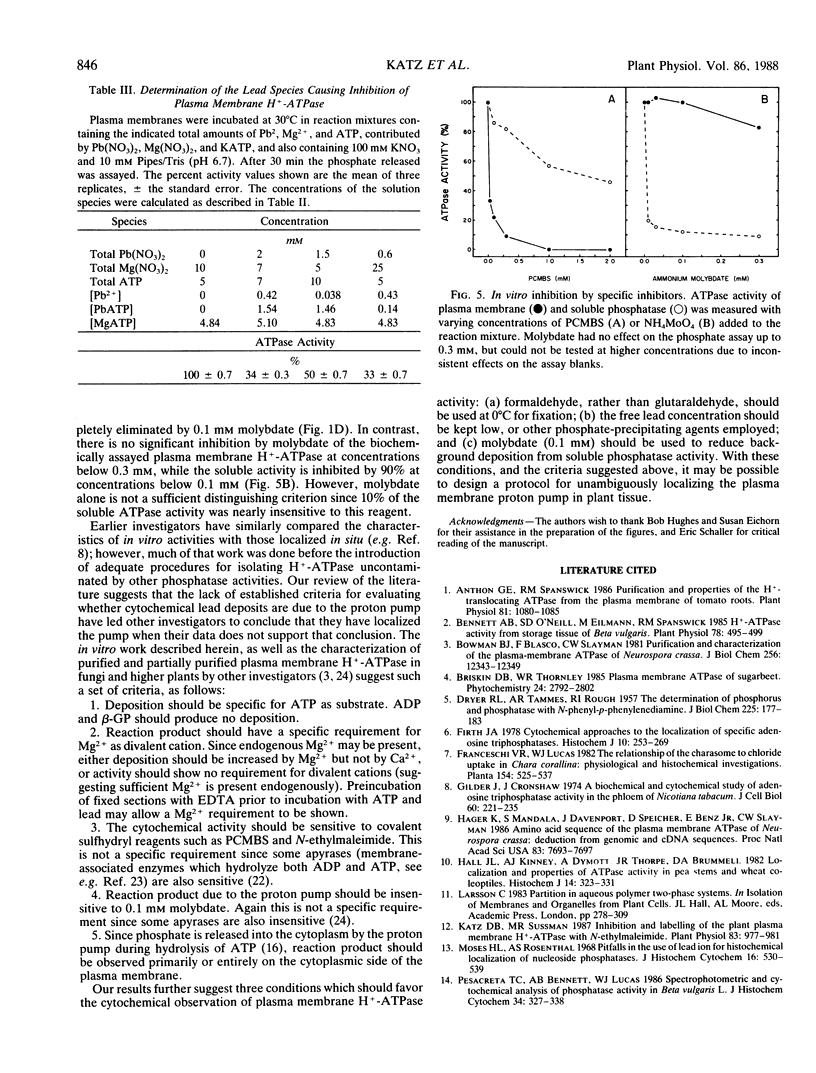

Images in this article
Selected References
These references are in PubMed. This may not be the complete list of references from this article.
- Anthon G. E., Spanswick R. M. Purification and properties of the h-translocating ATPase from the plasma membrane of tomato roots. Plant Physiol. 1986 Aug;81(4):1080–1085. doi: 10.1104/pp.81.4.1080. [DOI] [PMC free article] [PubMed] [Google Scholar]
- Bennett A. B., O'neill S. D., Eilmann M., Spanswick R. M. H-ATPase Activity from Storage Tissue of Beta vulgaris: III. Modulation of ATPase Activity by Reaction Substrates and Products. Plant Physiol. 1985 Jul;78(3):495–499. doi: 10.1104/pp.78.3.495. [DOI] [PMC free article] [PubMed] [Google Scholar]
- Bowman B. J., Blasco F., Slayman C. W. Purification and characterization of the plasma membrane ATPase of Neurospora crassa. J Biol Chem. 1981 Dec 10;256(23):12343–12349. [PubMed] [Google Scholar]
- DRYER R. L., TAMMES A. R., ROUTH J. I. The determination of phosphorus and phosphatase with N-phenyl-p-phenylenediamine. J Biol Chem. 1957 Mar;225(1):177–183. [PubMed] [Google Scholar]
- Firth J. A. Cytochemical approaches to the localization of specific adenosine triphosphatases. Histochem J. 1978 May;10(3):253–269. doi: 10.1007/BF01007558. [DOI] [PubMed] [Google Scholar]
- Gilder J., Cronshaw J. A biochemical and cytochemical study of adenosine triphosphatase activity in the phloem of Nicotiana tabacum. J Cell Biol. 1974 Jan;60(1):221–235. doi: 10.1083/jcb.60.1.221. [DOI] [PMC free article] [PubMed] [Google Scholar]
- Hager K. M., Mandala S. M., Davenport J. W., Speicher D. W., Benz E. J., Jr, Slayman C. W. Amino acid sequence of the plasma membrane ATPase of Neurospora crassa: deduction from genomic and cDNA sequences. Proc Natl Acad Sci U S A. 1986 Oct;83(20):7693–7697. doi: 10.1073/pnas.83.20.7693. [DOI] [PMC free article] [PubMed] [Google Scholar]
- Hall J. L., Kinney A. J., Dymott A., Thorpe J. R., Brummell D. A. Localization and properties of ATPase activity in pea stems and wheat coleoptiles. Histochem J. 1982 Mar;14(2):323–331. doi: 10.1007/BF01041224. [DOI] [PubMed] [Google Scholar]
- Katz D. B., Sussman M. R. Inhibition and Labeling of the Plant Plasma Membrane H-ATPase with N-Ethylmaleimide. Plant Physiol. 1987 Apr;83(4):977–981. doi: 10.1104/pp.83.4.977. [DOI] [PMC free article] [PubMed] [Google Scholar]
- Moses H. L., Rosenthal A. S. Pitfalls in the use of lead ion for histochemical localization of nucleoside phosphatases. J Histochem Cytochem. 1968 Aug;16(8):530–539. doi: 10.1177/16.8.530. [DOI] [PubMed] [Google Scholar]
- Pesacreta T. C., Bennett A. B., Lucas W. J. Spectrophotometric and cytochemical analyses of phosphatase activity in Beta vulgaris L. J Histochem Cytochem. 1986 Mar;34(3):327–338. doi: 10.1177/34.3.2419391. [DOI] [PubMed] [Google Scholar]
- Serrano R., Kielland-Brandt M. C., Fink G. R. Yeast plasma membrane ATPase is essential for growth and has homology with (Na+ + K+), K+- and Ca2+-ATPases. Nature. 1986 Feb 20;319(6055):689–693. doi: 10.1038/319689a0. [DOI] [PubMed] [Google Scholar]
- Spurr A. R. A low-viscosity epoxy resin embedding medium for electron microscopy. J Ultrastruct Res. 1969 Jan;26(1):31–43. doi: 10.1016/s0022-5320(69)90033-1. [DOI] [PubMed] [Google Scholar]
- Storer A. C., Cornish-Bowden A. Concentration of MgATP2- and other ions in solution. Calculation of the true concentrations of species present in mixtures of associating ions. Biochem J. 1976 Oct 1;159(1):1–5. doi: 10.1042/bj1590001. [DOI] [PMC free article] [PubMed] [Google Scholar]
- Tice L. W. Lead-adenosine triphosphate complexes in adenosine triphosphatase histochemistry. J Histochem Cytochem. 1969 Feb;17(2):85–94. doi: 10.1177/17.2.85. [DOI] [PubMed] [Google Scholar]
- Tognoli L., Marrè E. Purification and characterization of a divalent cation-activated ATP-ADPase from pea stem microsomes. Biochim Biophys Acta. 1981 Mar 20;642(1):1–14. doi: 10.1016/0005-2736(81)90132-2. [DOI] [PubMed] [Google Scholar]
- Vara F., Serrano R. Partial purification and properties of the proton-translocating ATPase of plant plasma membranes. J Biol Chem. 1982 Nov 10;257(21):12826–12830. [PubMed] [Google Scholar]
- Vara F., Serrano R. Purification and characterization of a membrane-bound ATP diphosphohydrolase from Cicer arietinum (chick-pea)roots. Biochem J. 1981 Sep 1;197(3):637–643. doi: 10.1042/bj1970637. [DOI] [PMC free article] [PubMed] [Google Scholar]
- WACHSTEIN M., MEISEL E. Histochemistry of hepatic phosphatases of a physiologic pH; with special reference to the demonstration of bile canaliculi. Am J Clin Pathol. 1957 Jan;27(1):13–23. doi: 10.1093/ajcp/27.1.13. [DOI] [PubMed] [Google Scholar]



